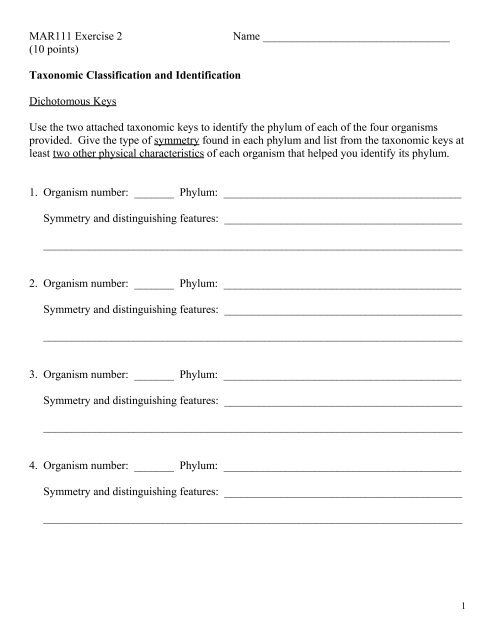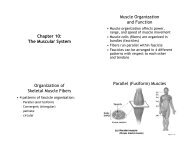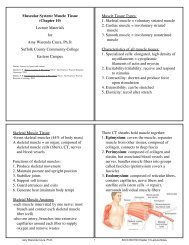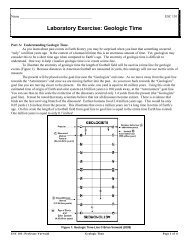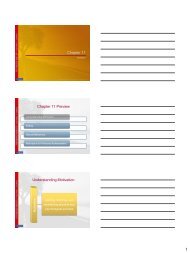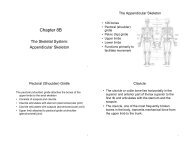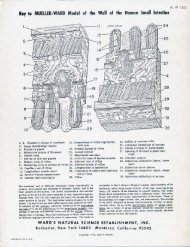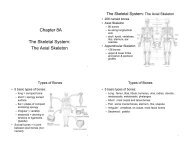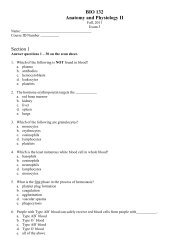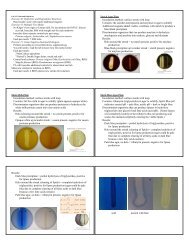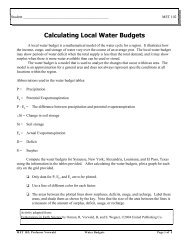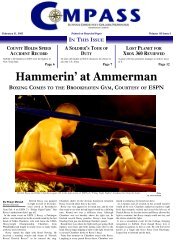MAR111 Exercise 2
MAR111 Exercise 2
MAR111 Exercise 2
Create successful ePaper yourself
Turn your PDF publications into a flip-book with our unique Google optimized e-Paper software.
<strong>MAR111</strong> <strong>Exercise</strong> 2 Name _________________________________<br />
(10 points)<br />
Taxonomic Classification and Identification<br />
Dichotomous Keys<br />
Use the two attached taxonomic keys to identify the phylum of each of the four organisms<br />
provided. Give the type of symmetry found in each phylum and list from the taxonomic keys at<br />
least two other physical characteristics of each organism that helped you identify its phylum.<br />
1. Organism number: _______ Phylum: __________________________________________<br />
Symmetry and distinguishing features: __________________________________________<br />
__________________________________________________________________________<br />
2. Organism number: _______ Phylum: __________________________________________<br />
Symmetry and distinguishing features: __________________________________________<br />
__________________________________________________________________________<br />
3. Organism number: _______ Phylum: __________________________________________<br />
Symmetry and distinguishing features: __________________________________________<br />
__________________________________________________________________________<br />
4. Organism number: _______ Phylum: __________________________________________<br />
Symmetry and distinguishing features: __________________________________________<br />
__________________________________________________________________________<br />
1
Classification<br />
Use the field guides provided and information below to identify the full classification (phylum,<br />
class, order, family, genus, and species) and common name for each of the six shells. Make<br />
sure to also identify the specimen number and draw a rough sketch showing distinguishing<br />
features and sizes labeled. Use the sheets attached for your drawings and identification.<br />
Geographic hint: All specimens are common ones found in the waters around Long Island.<br />
Phylum Mollusca - shell, mantle, and muscular foot usually present<br />
Class Polyplacophora (aka Amphineura) - shell made of eight plates<br />
Order Neoloricata (only living order)<br />
Class Bivalvia (aka Pelecypoda) - shell made of two parts joined by a hinge<br />
Order Mytiloida (mussels)<br />
Order Ostreoida (oysters and scallops)<br />
Order Veneroida (clams; most Families: Veneridae, etc.)<br />
Order Myoida (clams; Families Corbulidae, Erodonidae, Myidae, Spheniopsidae)<br />
Class Scaphopoda - single tube-shaped shell, open at both ends<br />
Order Dentaliida<br />
Order Gadilida<br />
Class Gastropoda - single coiled shell usually present, no chromatophores or<br />
tentacles/arms<br />
Order Neogastropoda (whelks, mud snails)<br />
Order Neotaenioglossa (conchs, periwinkles, slipper shells)<br />
Order Patellogastropoda (limpets)<br />
Order Nudibranchia (sea slugs)<br />
Order Stylommatophora (terrestrial snails and slugs)<br />
Class Cephalopoda - reduced or no shell usually present, chromatophores and<br />
tentacles/arms<br />
Order Decapoda (squid)<br />
Order Sepiida (cuttlefish)<br />
Order Octopoda (octopus)<br />
Order Nautilida (nautilus)<br />
(Incomplete mollusc classification, adapted from http://animaldiversity.ummz.umich.edu/site/index.html)<br />
2
Specimen No. Drawing:<br />
Phylum:<br />
Class:<br />
Order:<br />
Family:<br />
Genus:<br />
Species:<br />
Common name:<br />
Specimen No. Drawing:<br />
Phylum:<br />
Class:<br />
Order:<br />
Family:<br />
Genus:<br />
Species:<br />
Common name:<br />
3
Specimen No. Drawing:<br />
Phylum:<br />
Class:<br />
Order:<br />
Family:<br />
Genus:<br />
Species:<br />
Common name:<br />
Specimen No. Drawing:<br />
Phylum:<br />
Class:<br />
Order:<br />
Family:<br />
Genus:<br />
Species:<br />
Common name:<br />
4
Specimen No. Drawing:<br />
Phylum:<br />
Class:<br />
Order:<br />
Family:<br />
Genus:<br />
Species:<br />
Common name:<br />
Specimen No. Drawing:<br />
Phylum:<br />
Class:<br />
Order:<br />
Family:<br />
Genus:<br />
Species:<br />
Common name:<br />
5
Taxonomic Key to the Major Invertebrate Phyla<br />
Most taxonomic keys are “dichotomous,” (two branches), which is to say they are written with a series of<br />
two choices to be made about the anatomy of an animal (or photograph of an animal) you are looking at.<br />
Keys are not made to be read from start to finish like a book or a poem. In each numbered series you should<br />
read both choices, determine which choice best applies to the specimen you are looking at, then go where<br />
the key tells you to go, often skipping other steps in between that don’t apply.<br />
1. Radial symmetry or asymmetry…………………………………………….……………2<br />
Bilateral symmetry………………………………………….……………………………4<br />
2. Highly porous surface, not true tissues…………………………………Phylum Porifera<br />
Surface is not highly porous, true tissues present………………………………………..3<br />
3. Exhibits pentamerous symmetry and tube feet…………………Phylum Echinodermata<br />
Lacks pentamerous symmetry and tube feet, possesses tentacles<br />
(with nematocysts)……………………………………….……………Phylum Cnidaria<br />
4. Macroscopic colony of sessile, microscopic individuals, individuals ‹ 0.5 mm<br />
in size……………………………………………………..Phylum Ectoprocta (Bryozoa)<br />
Solitary or colonial in form, individuals of colony › 0.5 mm in size………………….…5<br />
5. Gelatinous………………………………………………………………………………..6<br />
Not gelatinous……………………………………………………………………………7<br />
6. Solitary individuals with 8 rows of comb plates……………….……Phylum Ctenophora<br />
Solitary and/or colonial with incurrent and excurrent siphons, and a gelatinous exterior called a<br />
tunic.………………………..............…………………………………..Phylum Chordata<br />
7. Possesses segmentation…………………………………………………………………..8<br />
Lacks segmentation………………………...…………………………………………….9<br />
8. Exoskeleton with jointed appendages……………………………….Phylum Arthropoda<br />
No exoskeleton, appendages, if present, not jointed, segmented worm-like body, possibly in a tube (if<br />
in a tube, may have tentacles)…………....................………………….Phylum Annelida<br />
9. Possesses a foot, radula, arms and/or shell……………………………Phylum Mollusca<br />
Lacking all of above, dorso-ventrally flattened to a thickness of less than<br />
1 mm……………………………………..……………………..Phylum Platyhelminthes<br />
(From http://www.msc.ucla.edu/oceanglobe/pdf/Invertebrates/Inverts_Entire.pdf)<br />
6
(From page 23 of Laboratory and Field Investigations in Marine Life, 8th edition, J.L. Sumich and G. Dudley,<br />
Jones & Bartlett Publishers, 2005.)<br />
Symmetry in Animals<br />
Asymmetry = no symmetry<br />
Radial = many planes of symmetry (like<br />
spokes of a wheel)<br />
Bilateral = one plane of symmetry from the head to<br />
the tail<br />
7


